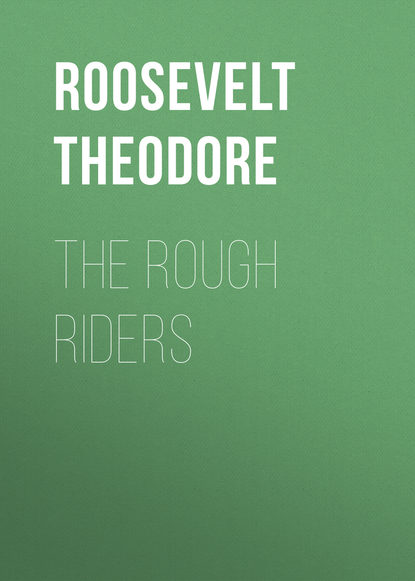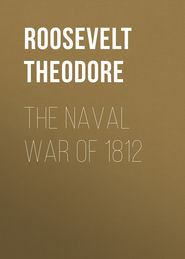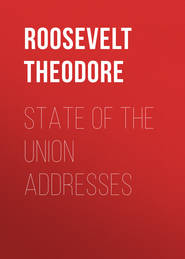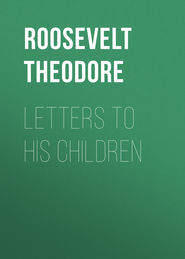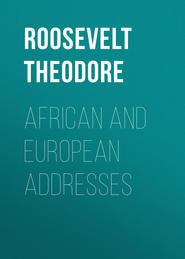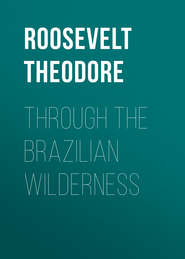По всем вопросам обращайтесь на: info@litportal.ru
(©) 2003-2024.
✖
The Rough Riders
Настройки чтения
Размер шрифта
Высота строк
Поля
2
Lieutenant Tejeiro, p. 154, speaks of this attempt to retake San Juan and its failure.
3
According to the official reports, 5,104 officers and men of Kent's infantry, and 2,649 of the cavalry had been landed. My regiment is put down as 542 strong, instead of the real figure, 490, the difference being due to men who were in hospital and on guard at the seashore, etc. In other words, the total represents the total landed; the details, etc., are included. General Wheeler, in his report of July 7th, puts these details as about fifteen per cent of the whole of the force which was on the transports; about eighty-five per cent got forward and was in the fight.
4
The total Spanish force in Santiago under General Linares was 6,000: 4,000 regulars, 1,000 volunteers, and 1,000 marines and sailors from the ships. (Diary of the British Consul, Frederick W. Ramsden, entry of July 1st.) Four thousand more troops entered next day. Of the 6,000 troops, 600 or thereabouts were at El Caney, and 900 in the forts at the mouth of the harbor. Lieutenant Tejeiro states that there were 520 men at El Caney, 970 in the forts at the mouth of the harbor, and 3,000 in the lines, not counting the cavalry and civil guard which were in reserve. He certainly very much understates the Spanish force; thus he nowhere accounts for the engineers mentioned on p. 135; and his figures would make the total number of Spanish artillerymen but 32. He excludes the cavalry, the civil guard, and the marines which had been stationed at the Plaza del Toros; yet he later mentions that these marines were brought up, and their commander, Bustamente, severely wounded; he states that the cavalry advanced to cover the retreat of the infantry, and I myself saw the cavalry come forward, for the most part dismounted, when the Spaniards attempted a forward movement late in the afternoon, and we shot many of their horses; while later I saw and conversed with officers and men of the civil guard who had been wounded at the same time—this in connection with returning them their wives and children, after the latter had fled from the city. Although the engineers are excluded, Lieutenant Tejeiro mentions that their colonel, as well as the colonel of the artillery, was wounded. Four thousand five hundred is surely an understatement of the forces which resisted the attack of the forces under Wheeler. Lieutenant Tejeiro is very careless in his figures. Thus in one place he states that the position of San Juan was held by two companies comprising 250 soldiers. Later he says it was held by three companies, whose strength he puts at 300—thus making them average 100 instead of 125 men apiece. He then mentions another echelon of two companies, so situated as to cross their fire with the others. Doubtless the block-house and trenches at Fort San Juan proper were only held by three or four hundred men; they were taken by the Sixth and Sixteenth Infantry under Hawkins's immediate command; and they formed but one point in the line of hills, trenches, ranch-houses, and block-houses which the Spaniards held, and from which we drove them. When the city capitulated later, over 8,000 unwounded troops and over 16,000 rifles and carbines were surrendered; by that time the marines and sailors had of course gone, and the volunteers had disbanded.
In all these figures I have taken merely the statements from the Spanish side. I am inclined to think the actual numbers were much greater than those here given. Lieutenant Wiley, in his book In Cuba with Shafter, which is practically an official statement, states that nearly 11,000 Spanish troops were surrendered; and this is the number given by the Spaniards themselves in the remarkable letter the captured soldiers addressed to General Shafter, which Wiley quotes in full. Lieutenant Tejeiro, in his chap. xiv., explains that the volunteers had disbanded before the end came, and the marines and sailors had of course gone, while nearly a thousand men had been killed or captured or had died of wounds and disease, so that there must have been at least 14,000 all told. Subtracting the reinforcements who arrived on the 2nd, this would mean about 10,000 Spaniards present on the 1st; in which case Kent and Wheeler were opposed by at least equal numbers.
In dealing with the Spanish losses, Lieutenant Tejeiro contradicts himself. He puts their total loss on this day at 593, including 94 killed, 121 missing, and 2 prisoners—217 in all. Yet he states that of the 520 men at Caney but 80 got back, the remaining 440 being killed, captured, or missing. When we captured the city we found in the hospitals over 2,000 seriously wounded and sick Spaniards; on making inquiries, I found that over a third were wounded. From these facts I feel that it is safe to put down the total Spanish loss in battle as at least 1,200, of whom over a thousand were killed and wounded.
Lieutenant Tejeiro, while rightly claiming credit for the courage shown by the Spaniards, also praises the courage and resolution of the Americans, saying that they fought, "con un arrojo y una decision verdaderamente admirables." He dwells repeatedly upon the determination with which our troops kept charging though themselves unprotected by cover. As for the Spanish troops, all who fought them that day will most freely admit the courage they showed. At El Caney, where they were nearly hemmed in, they made a most desperate defence; at San Juan the way to retreat was open, and so, though they were seven times as numerous, they fought with less desperation, but still very gallantly.
5
This is probably an understatement. Lieutenant Muller, in chap. xxxviii. of his book, says that there were "eight or nine thousand;" this is exclusive of the men from the fleet, and apparently also of many of the volunteers (see chap. xiv.), all of whom were present on July 2nd. I am inclined to think that on the evening of that day there were more Spanish troops inside Santiago than there were American troops outside.
6
See Parker's "With the Gatlings at Santiago."
7
The other two must have followed on their own initiative.
8
These were the Spaniards in the trenches we carried when we charged from Kettle Hill, after the infantry had taken the San Juan block-house.
Lieutenant Tejeiro, p. 154, speaks of this attempt to retake San Juan and its failure.
3
According to the official reports, 5,104 officers and men of Kent's infantry, and 2,649 of the cavalry had been landed. My regiment is put down as 542 strong, instead of the real figure, 490, the difference being due to men who were in hospital and on guard at the seashore, etc. In other words, the total represents the total landed; the details, etc., are included. General Wheeler, in his report of July 7th, puts these details as about fifteen per cent of the whole of the force which was on the transports; about eighty-five per cent got forward and was in the fight.
4
The total Spanish force in Santiago under General Linares was 6,000: 4,000 regulars, 1,000 volunteers, and 1,000 marines and sailors from the ships. (Diary of the British Consul, Frederick W. Ramsden, entry of July 1st.) Four thousand more troops entered next day. Of the 6,000 troops, 600 or thereabouts were at El Caney, and 900 in the forts at the mouth of the harbor. Lieutenant Tejeiro states that there were 520 men at El Caney, 970 in the forts at the mouth of the harbor, and 3,000 in the lines, not counting the cavalry and civil guard which were in reserve. He certainly very much understates the Spanish force; thus he nowhere accounts for the engineers mentioned on p. 135; and his figures would make the total number of Spanish artillerymen but 32. He excludes the cavalry, the civil guard, and the marines which had been stationed at the Plaza del Toros; yet he later mentions that these marines were brought up, and their commander, Bustamente, severely wounded; he states that the cavalry advanced to cover the retreat of the infantry, and I myself saw the cavalry come forward, for the most part dismounted, when the Spaniards attempted a forward movement late in the afternoon, and we shot many of their horses; while later I saw and conversed with officers and men of the civil guard who had been wounded at the same time—this in connection with returning them their wives and children, after the latter had fled from the city. Although the engineers are excluded, Lieutenant Tejeiro mentions that their colonel, as well as the colonel of the artillery, was wounded. Four thousand five hundred is surely an understatement of the forces which resisted the attack of the forces under Wheeler. Lieutenant Tejeiro is very careless in his figures. Thus in one place he states that the position of San Juan was held by two companies comprising 250 soldiers. Later he says it was held by three companies, whose strength he puts at 300—thus making them average 100 instead of 125 men apiece. He then mentions another echelon of two companies, so situated as to cross their fire with the others. Doubtless the block-house and trenches at Fort San Juan proper were only held by three or four hundred men; they were taken by the Sixth and Sixteenth Infantry under Hawkins's immediate command; and they formed but one point in the line of hills, trenches, ranch-houses, and block-houses which the Spaniards held, and from which we drove them. When the city capitulated later, over 8,000 unwounded troops and over 16,000 rifles and carbines were surrendered; by that time the marines and sailors had of course gone, and the volunteers had disbanded.
In all these figures I have taken merely the statements from the Spanish side. I am inclined to think the actual numbers were much greater than those here given. Lieutenant Wiley, in his book In Cuba with Shafter, which is practically an official statement, states that nearly 11,000 Spanish troops were surrendered; and this is the number given by the Spaniards themselves in the remarkable letter the captured soldiers addressed to General Shafter, which Wiley quotes in full. Lieutenant Tejeiro, in his chap. xiv., explains that the volunteers had disbanded before the end came, and the marines and sailors had of course gone, while nearly a thousand men had been killed or captured or had died of wounds and disease, so that there must have been at least 14,000 all told. Subtracting the reinforcements who arrived on the 2nd, this would mean about 10,000 Spaniards present on the 1st; in which case Kent and Wheeler were opposed by at least equal numbers.
In dealing with the Spanish losses, Lieutenant Tejeiro contradicts himself. He puts their total loss on this day at 593, including 94 killed, 121 missing, and 2 prisoners—217 in all. Yet he states that of the 520 men at Caney but 80 got back, the remaining 440 being killed, captured, or missing. When we captured the city we found in the hospitals over 2,000 seriously wounded and sick Spaniards; on making inquiries, I found that over a third were wounded. From these facts I feel that it is safe to put down the total Spanish loss in battle as at least 1,200, of whom over a thousand were killed and wounded.
Lieutenant Tejeiro, while rightly claiming credit for the courage shown by the Spaniards, also praises the courage and resolution of the Americans, saying that they fought, "con un arrojo y una decision verdaderamente admirables." He dwells repeatedly upon the determination with which our troops kept charging though themselves unprotected by cover. As for the Spanish troops, all who fought them that day will most freely admit the courage they showed. At El Caney, where they were nearly hemmed in, they made a most desperate defence; at San Juan the way to retreat was open, and so, though they were seven times as numerous, they fought with less desperation, but still very gallantly.
5
This is probably an understatement. Lieutenant Muller, in chap. xxxviii. of his book, says that there were "eight or nine thousand;" this is exclusive of the men from the fleet, and apparently also of many of the volunteers (see chap. xiv.), all of whom were present on July 2nd. I am inclined to think that on the evening of that day there were more Spanish troops inside Santiago than there were American troops outside.
6
See Parker's "With the Gatlings at Santiago."
7
The other two must have followed on their own initiative.
8
These were the Spaniards in the trenches we carried when we charged from Kettle Hill, after the infantry had taken the San Juan block-house.





